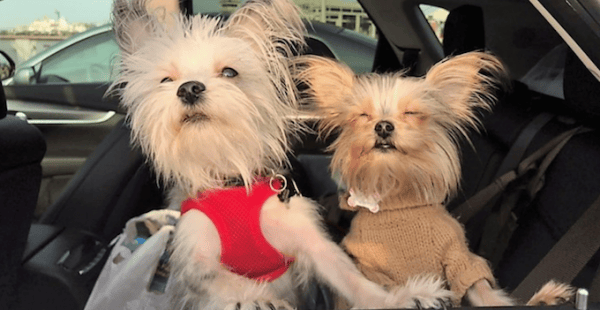Love to Road Trip? How a Dog Seat Belt for Pet Travel Can Help Fido Love The Ride

Yes, you can teach old dogs new tricks.
We love to road trip. So does our dog Eli. But he is not a happy traveler when he has to be strapped into a seat restraint.
Making this tougher is that many states now have pet restraint laws, from outright dog seat belt laws to charging drivers with distracted driving if a pet is unrestrained in a car. Traveling with a dog or cat roaming the cabin can be very unsafe, from distracted drivers trying to manage the joy of the ride to little Eli becoming a projectile in a crash. But we have to face reality: We have to find a safe way to travel with our pets.
Safe Pet Travel With a Dog Seat Belt or Carrier Begins With Training
It can be a challenge when our dogs and cats resist our efforts to put them in a seat restraint. But with a little convincing, it can work. Pet restraint maker Sleepypod says that letting your pet get familiar with the process is a great way to start. Here’s how to acclimate your pet to its new carrier or safety harness before heading out on a road adventure or even a short trip:
Step 1: Choose the Right Gear
Start by choosing the right restraint for your pet’s size. For smaller pets, look for a carrier that has been crash tested and certified by the Center for Pet Safety. Based on research and testing, the CPS has determined that a carrier is best for restraining smaller pets under about 18 lbs (like people, pets come in all shapes and sizes so this is a meant to be a rough guideline). To find the right size carrier, measure the pet’s length and height and compare against the dimensions of the carrier. The carrier size should be proportionate to the size of the pet. When in motion, the pet should be able to slide in the empty space.
Remember: Cats have smaller frames than dogs so should always ride in a carrier and never a safety harness.
For larger dogs weighing more than about 18 lbs., buckle up using a CPS certified safety harness. The Center for Pet Safety recommends harnesses without tethers. You can find additional recommendations on their web site at CenterForPetSafety.org.
Further Reading: How to choose the right car for travel with your pet

Sleepypod’s crash tested restraints and carriers ensure your pet’s safety, and yours. Photo: Sleepypod
Step 2: Let the Pet Sniff the Carrier or Harness
Gradually introduce the pet to his carrier or harness in the days or weeks prior to travel, one step at a time. Start by placing the carrier or harness in a favorite or familiar spot at home and let the pet investigate. As soon as he sniffs or touches it, give him a positive reward of praise and treat.
Step 3: Gradually Expose Pet to Buckle or Zipper Noises
Next, let the pet hear the noises of the restraint’s zipper or buckle. When he accepts the noise, give him a reward of praise and treat.
Step 4: Integrate the Safety Restraint in a Pet’s Everyday Routine
For carrier users: Place familiar toys or comfort items inside and let the pet use it as an everyday bed. For particularly fearful pets, you might even try placing a small article of clothing with the owner’s scent inside the carrier. Allow the pet to roam in and out and explore. Be sure he’s comfortable with it before you zip the carrier with the pet inside.
Remember: Never put the pet inside the carrier as a punishment. A carrier should always be a happy place.
For harness users: Work your way up to putting the harness on the dog for longer periods of a time, offering a reward with each successful step. Then have him play, eat, or do other fun activities while wearing his harness. For some dogs, the gentle pressure of a harness can have a calming effect and can help ease travel anxiety.
Further Reading: Car seat covers that keep Fido’s fur off your upholstery

The Sleepypod carrier is ideal for smaller pets. Photo: Sleepypod
Step 5: Familiarize the Pet with Restricted Movement When in a Car
When introducing the pet to a car, make sure the temperature inside is a comfortable temperature. Buckle up the pet in the back seat. If you are not using a CPS approved carrier or harness, position the pet in the rear footwell to prevent it from sliding in the car. Sit next to the pet while going nowhere, offering encouragement, praise, and reward.
Step 6: Practice Short Outings Then Build to Longer Trips
Practice short outings in the car to get the pet accustomed to the motion of travel. Your practice destinations should be happy destinations like the park or the home a familiar friend.
When All Else Fails
For some pets, this process might require more time and successive trial runs. If a pet continues to show fear or anxiety, consult a veterinarian for a remedy for anxiety or a synthetic pheromone suggestion.
And then, hit the road and have fun out there!

